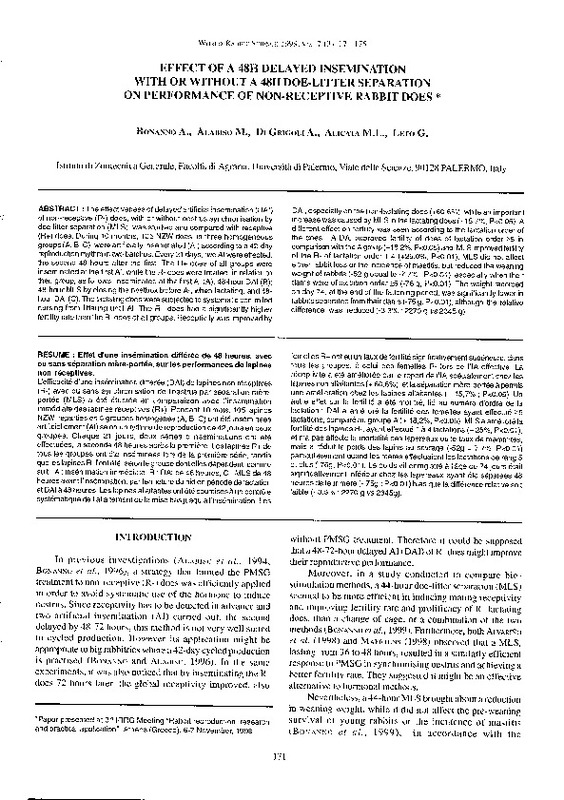JavaScript is disabled for your browser. Some features of this site may not work without it.
Buscar en RiuNet
Listar
Mi cuenta
Estadísticas
Ayuda RiuNet
Admin. UPV
EFFECT OF A 48H DELAYED INSEMINATION WITH OR WITHOUT A 48H DOE-LITTER SEPARATION ON PERFORMANCE OF NON-RECEPTIVE RABBIT DOES
Mostrar el registro sencillo del ítem
Ficheros en el ítem
| dc.contributor.author | Bonanno, A.
|
|
| dc.contributor.author | Alabiso, M.
|
|
| dc.contributor.author | Di Grigoli, A.
|
|
| dc.contributor.author | Alicata, M.L.
|
|
| dc.contributor.author | Leto, G.
|
|
| dc.date.accessioned | 2011-03-11T13:07:15Z | |
| dc.date.available | 2011-03-11T13:07:15Z | |
| dc.date.issued | 1999 | |
| dc.identifier.issn | 1257-5011 | |
| dc.identifier.uri | http://hdl.handle.net/10251/10286 | |
| dc.description.abstract | [EN] The effectiveness of delayed artificial insemination (DAI) of non-receptive (R-) does, with or without oestrus synchronisation by doe-litter separation (MLS), was studied and compared with receptive (R+) does. During 10 months, 105 NZW does, in three homogeneous groups (A, B, C), were artificially inseminated (Al) according to a 42-day reproduction rhythm in two batches. Every 21 days, two Al were effected, the second 48 hours alter the first. The R+ does of ali groups were inseminated al the first Al, while the R- does were treated, in relation to theirgroup, as follows: inseminated at the first Al (A); 48-hour DAI (B); 48-hour MLS by closing the nestbox before Al, when lactating, and 48- hour DAI (C). The lactating does were subjected to systematic controlled nursing from littering until Al. The R+ does had a significantly higher fertility rate than the R- does of all groups. Receptivity was improved by DAI, especially on the non-lactating does (+60.6%), while an importan! increase was caused by MLS in the lactatingdoes (+ 15.7%, P<0.05). A difieren! effect on fertility was seen according to the lactation order of the does. A DAI improved fertility of does of lactation order ~5 in comparison with the A group ( + 18.2%, P<0.05) and MLS improved fertility of the R- of lactation order 1-4 (+25.0%, P<0.01). MLS did not affect either rabbit loss or the incidence of mastitis, but reduced the weaning weight of rabbits (-52 g equal to -7.7%, P<0.01), especially when their dams were of lactation order~5 (-76 g, P<0.01). The weight recorded on day 74, at the end of the fattening period, was significantly lower in rabbits separated from theirdams (-75 g, P<0.01), although the relative difference was reduced (-3.3% : 2270 g vs 2345 g). | es_ES |
| dc.description.abstract | [FR] L'efficacité d'une insémination différée (DAI) de lapines non réceptives (R-) avec ou sans synchronisation de l'oestrus par séparation mereportée (MLS) a été étudiée en comparaison avec l'insémination immédiate des lapines réceptives (R+). Pendan! 10 mois, 105 lapines NZW, repartiesen 3 groupes homogenes (A, B, C) ont été inséminées artificiellement (Al) selon un rythme de reproduction de 42 jours en deux groupes. Chaque 21 jours, deux séries d'inséminations ont été effectuées, la seconde 48 heures apres la premiare. Les lapines R+ de tous les groupes ont été inséminées lors de la premiere série, tandis que les lapines R- l'ont été, selon le groupe dont elles dépendent, comme suit: A: insémination immédiate, B : DAI de 48 heures, C : MLS de 48 heures avant l'insémination, par fermeture du nid en période de lactation et DAI a 48 heures. Les lapines allaitantes ont été soumises a un controle systématique de l'allaitement de la mise bas jusqu'a l'insémination. Les femelles R+ ont eu un taux de fertilité significativement supérieure, dans tous les groupes, a celui des femelles R- lors de l'IA effective. La réceptivité a été améliorée par le report de l'IA spécialement chez les lapines non allaitantes ( + 60,6%), et la séparation mere-portée a permis une amélioration chez les lapines allaitantes (+ 15,7%; P<0.05). Un autre effet sur la fertilité a été montré, lié au numéro d'ordre de la lactation : DAI a amélioré la fertilité des femelles ayant effectué ~5 lactations, comparé au groupe A(+ 18,2%, P<0.05). MLS a amélioré la fertilité des lapines R-, ayant effectué 1 a 4 lactations ( + 25%, P<0.01 ), et n'a pas affecté la mortalité des lapereaux ou le taux de mammites, mais a réduit le poids des lapins au sevrage (-52g = 7,7%, P<0.01) particulierement quand les meres effectuaient les lactations de rang 5 et plus (-76g, P<0.01 ). Le poids vif enregistré a l'age de 74 jours était significativement inférieur chez les lapereaux ayant été séparées 48 heures de leur mere (- 75g ; P<0.01) bien que la différence relative soit faible (- 3,3%: 2270 g vs 2345g). | |
| dc.language | Inglés | es_ES |
| dc.publisher | World Rabbit Science. ICTA. UPV | es_ES |
| dc.relation.ispartof | World Rabbit Science | |
| dc.rights | Reserva de todos los derechos | es_ES |
| dc.title | EFFECT OF A 48H DELAYED INSEMINATION WITH OR WITHOUT A 48H DOE-LITTER SEPARATION ON PERFORMANCE OF NON-RECEPTIVE RABBIT DOES | es_ES |
| dc.type | Artículo | es_ES |
| dc.date.updated | 2011-03-11T12:52:36Z | |
| dc.identifier.doi | 10.4995/wrs.1999.397 | |
| dc.rights.accessRights | Abierto | es_ES |
| dc.description.bibliographicCitation | Bonanno, A.; Alabiso, M.; Di Grigoli, A.; Alicata, M.; Leto, G. (1999). EFFECT OF A 48H DELAYED INSEMINATION WITH OR WITHOUT A 48H DOE-LITTER SEPARATION ON PERFORMANCE OF NON-RECEPTIVE RABBIT DOES. World Rabbit Science. 07(3). https://doi.org/10.4995/wrs.1999.397 | es_ES |
| dc.description.accrualMethod | SWORD | es_ES |
| dc.relation.publisherversion | https://doi.org/10.4995/wrs.1999.397 | |
| dc.description.volume | 07 | |
| dc.description.issue | 3 | |
| dc.identifier.eissn | 1989-8886 | es_ES |








